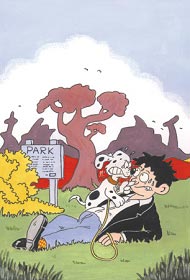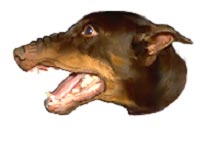What
is aggression?
Aggression
is defined as threats or harmful
actions directed toward another
individual. In animals, aggressive
behaviors are a means of communication.
Dogs and cats use aggressive
displays, threats and attacks
to resolve competitive disputes
over resources (territory, food)
or to increase their reproductive
potential. "Aggression"
describes the behavior, but
does not give any information
about underlying motives or
causes. Aggression can have
multiple motivations.
How
is aggression classified?
Aggression
can be subdivided into type
based on intended victim, body
postures during aggression,
and other factors such as the
animal may want, estrus status
of animals involved, and location
of the aggressive encounter.
In determining the diagnosis,
the factors surrounding the
initial aggressive event are
important considerations, since
over time the effects of learning
(consequences) including the
actions of the owner and the
stimulus (i.e. person or other
pet retaliates or retreats)
will affect how the aggression
is displayed.
 Ethologists,
persons who study animal behavior,
use the term ‘agonistic'
to refer to the behavior of
animals (usually of the same
species) that involves conflict
or contest. These encounters
can involve fighting, escape,
dominant and submissive gestures
and posturing. Aggressive behavior
can also be divided into offensive
and defensive aggression. In
dogs and cats the supposed function
of the aggression is most commonly
used as the basis of classification: Ethologists,
persons who study animal behavior,
use the term ‘agonistic'
to refer to the behavior of
animals (usually of the same
species) that involves conflict
or contest. These encounters
can involve fighting, escape,
dominant and submissive gestures
and posturing. Aggressive behavior
can also be divided into offensive
and defensive aggression. In
dogs and cats the supposed function
of the aggression is most commonly
used as the basis of classification:
Dominance
(status related) related, possessive,
protective and territorial,
predatory, fear induced, pain-induced,
parental, redirected, play,
intermale, interfemale, and
pathophysiologic (medical) in
origin.
Note
that there is no one single
cause of aggression. In addition,
an individual pet can display
one or more forms of aggression
and that multiple factors and
stimuli may combine to push
the dog or cat to a point where
aggression is displayed. For
example, a dog may be territorial
as well as fearful of children.
This dog can only exhibit aggression
however, when it is cornered
or tied up and cannot escape,
and a strange child comes onto
the dog's property. When
the dog learns that snapping
or growls are successful at
chasing the child away who has
been hugging the dog, the dog
may begin to generalize its
aggression toward similar stimuli
(e.g. other children) and similar
situations (hugging).
Are
aggressive dogs and cats abnormal?
Aggressive
behaviors may be "normal",
but when they result in human
or animal injury, the behavior
is dangerous and unacceptable.
Human safety must always be
a primary consideration when
discussing aggression. More
than two million bite wounds
occur annually across North
America and most people are
bitten by animals they own or
are known to them. It is important
to be able to identify aggressive
dogs and cats to prevent injuries
wherever possible.
Some
aggression in dogs and cats
may have abnormal components
and be the result of genetics,
disease conditions ranging from
hormonal imbalances to organ
disease, environmental influences
or experience and learning.
However, even though health
problems and degenerative changes
may be present, they may or
may not contribute to the aggressive
behavior. 
How
do dogs communicate their aggressive
behaviors?
By
watching the body postures and
facial expressions of dogs,
it is possible to find an indication
of what the dog may do. When
a dog is reacting to intrusion,
the first sign may be eye contact
as when two dogs meet. In some
cases, the more dominant dog
will maintain eye contact, until
the more subordinate dog looks
away.
Prolonged
eye contact may be considered
a threat by both dominant and
subordinate dogs. Dogs that
are acting subordinate by looking
away may feel threatened by
continued eye contact and bite
out of fear. A dominant and/or
assertive dog can react to continued
eye contact by holding the stare
and escalating its aggressive
threat. In some dogs a dark
iris or hair occluding the eyes
may make eye contact difficult
to ascertain.
What
happens next?
If
the dog believes the intrusion
is continuing, the dog may escalate
the threat by exposing the teeth
and snarling. Snarling is not
always accompanied by growling
and may only be an upward movement
of the lips. Long pendulous
lips, long hair or beards on
the face may obscure seeing
such lip movements. Ear position
in dogs can also give clues
to canine intentions. A subordinate
dog will usually place the ears
back as will a fearful dog.
An assertive dog will have ears
erect. Again, visualization
of these positions can be inhibited
by conformation, coat and cosmetic
surgery.
Dogs
will also attempt to change
the way they position their
body in reaction to a perceived
threat. A dog standing its ground
tries to look "bigger"
by raising the hair along the
neck and back, raising the tail
in a high position and slowly
wagging its tail from side to
side. Other dogs attempt to
look "smaller" by
crouching down, tucking the
tail between the legs and even
rolling over. Crouching and
a lowered body posture in dogs
is an appeasement posture designed
to decrease the aggressive threat.
While maintaining either of
these postures a dog may be
growling, snarling or barking.
These postures can result in
a stand off, a decrease or an
increase in the aggression.
What does an aggressive
cat look like?
Often
the first sign is a dilation
of the pupils (the dark part
of the eye) and rapid lateral
movements of the tail. This
may be accompanied by putting
the ears back and hissing or
growling. In addition, the cat
may "swipe" at the
intruder with a front paw, either
with the claws sheathed or exposed.
Sometimes the cat will gather
its legs under and appear ready
to pounce. If the intruder is
not too close, or begins to
leave, the aggressive encounter
may end.
Cats
have other more dramatic body
postures that signal "go
away". Cats frequently
try to enhance their size and
ferocity to make the threat
more menacing. They will do
this by turning sideways to
the intruder, arching their
back, holding the tail upright
or straight down, and having
their fur stand up. They may
hiss, growl and yowl at the
same time. In other situations
a cat may crouch down, tail
switching back and forth with
the ears tight against the head,
again with accompanying vocalization.
A cat anticipating a fight may
roll onto its back with claws
extended ready to fend off a
foe.
How
should I respond to these behaviors?
The
distance between the animal
and the intruder can be influential
in determining response. This
is often called the "flight"
distance. If the intrusion is
far away the animal may choose
to flee, but if the intrusion
is very close the animal may
choose to fight. If flight is
inhibited, as in a dog or cat
that is cornered or tied up,
aggression or fight is likely
to occur. Most dogs, and some
cats, on their own territory
are more likely to fight than
retreat and dogs with their
owners may also stay close rather
than retreating. When approached
rapidly, a dog or cat may go
through the stages of aggressive
behavior very quickly and bite
without the intruder being able
to react. This may happen in
encounters between people and
their pets because they may
approach too close, too fast.
On a similar note, dogs that
are highly aroused may react
with a defensive response almost
reflexively in comparison to
a dog that is calm enough to
make a quick assessment of the
approaching stimulus and "decide"
on the appropriate response.
Dogs and cats that are mildly
fearful may calm down if the
intruder shows no fear, waits
until the pet settles, and then
offers a food reward. Reaching
for a dog or cat, while continuing
to advance is most likely to
lead to aggression. Standing
still is often the best way
to reduce aggression in the
dog that is chasing.
 Cats
will often flee if given the
opportunity. However some cats
will stand their ground and
will scratch or bite if reached
for. Bites are most likely if
the cat is cornered or restrained
and cannot escape, but some
bold, confident cats will exhibit
territorial displays to intruders
on their property in much the
same manner as they might chase
another cat off of the territory. Cats
will often flee if given the
opportunity. However some cats
will stand their ground and
will scratch or bite if reached
for. Bites are most likely if
the cat is cornered or restrained
and cannot escape, but some
bold, confident cats will exhibit
territorial displays to intruders
on their property in much the
same manner as they might chase
another cat off of the territory.
In
some cases, despite standing
still, avoiding further advance
or retreating, the aggression
continues. Since aggression
depends on the situation, the
pet's level of motivation,
previous experiences and the
type of aggression, it will
be necessary for you to provide
a detailed history to your veterinarian
in order that an accurate diagnosis,
and appropriate treatment plan
be established. Details on the
diagnosis and types of aggression
in dogs and cats can be found
in separate handouts.
This
client information sheet is
based on material written by
Debra Horwitz, DVM, DACVB and
Gary Landsberg, DVM, DACVB.
© Copyright 2002 Lifelearn
Inc. Used with permission under
license. March 11, 2004. |